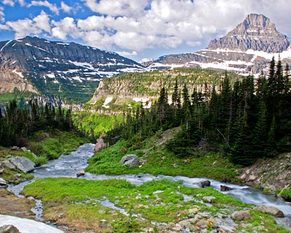 Montana's Rocky Mountains
Montana's Rocky Mountains
This marked the second time that he had been in the Rocky Mountains, but it certainly wouldn’t be his last. De Smet was an adventurous priest, one more apt to go out and explore than sit behind a desk all day.
And explore he did. Over the next several years he’d leave the Rocky Mountains and his beloved mission and return again. He’d head all the way to the Columbia River and then back east.
He’d sail to Europe nineteen times and come back once around Cape Horn to land directly in Oregon. But on September 24, 1841, all he wanted to do was rest for a few days.
Getting Things Underway
 St. Mary's Mission, c 1900
St. Mary's Mission, c 1900
The Flathead, Iroquois, and neighboring Nez Pearce all took an active interest in ensuring that the men were as comfortable as could be, the better for them to begin carrying out their task, which was to begin the work of saving souls.
The Jesuits felt that nothing would accomplish or accommodate that more than a chapel which could hold every Indian of the tribe. Even with winter setting in they accomplished the task, constructing a two-gallery cottonwood log chapel measuring 25x33 feet.
The Hudson Bay Company was operating at Fort Colville, about 300 miles to the northwest. The fort had been constructed on the edge of Kettle Falls in 1825 and served as on of the main bases of operation for the company.
There was still time in the season so Father Pierre De Smet set out for supplies, and he did just that on October 28th. The group stopped for a rest on November 7th at Lake Pend d’Oreille, where they met up with a Flathead Indian bearing letters from Fort Vancouver, inviting De Smet to attend there as soon as he was able.
To Fort Vancouver and the Hudson’s Bay Company
 Kettle Falls in 1860
Kettle Falls in 1860
The group secured the seeds they wanted for planting, but were unable to obtain any livestock. De Smet’s discouragement was no doubt dispelled when he received an extra package of foodstuffs containing such rare goods a sugar, coffee, chocolate, and ham.
The group turned about and followed the same course back, reaching St. Mary’s on December 8th, just before winter set in. They had secured the necessary winter supplies of oats, vegetables, wheat, and perhaps most importantly, the seeds for the next year’s crops.
Things had changes substantially in the forty-two days that De Smet had been away. A large palisade completely enclosed the now-noticeable village, made up of more than 3,000 large wooden stakes.
Fields were already fenced off for next year’s planting, and several buildings now stood where none had before. And to cap the year off Chief Big Face died, his dream of having “Black Robes” come to his people finally fulfilled.
Baumler, Ellen. Montana Moments: History on the Go. Montana Historical Society Press: Helena, 2010. p 125.
Carriker, Robert C. Father Peter John De Smet: Jesuit in the West. University of Oklahoma Press: Norman, 1995. p 31-64.
“History of St. Mary’s.” Historic St. Mary’s Mission & Museum. Web. Retrieved 7 June 2013 from Stmarysmission.org: http://www.saintmarysmission.org/history.html
Malone, Michael Peter; Roeder, Richard B.; Lang, William L. Montana: A History of Two Centuries. The University of Washington Press, 1976. p 62-3.
McLynne, Frank. Wagons West: The Epic Story of America’s Overland Trails. Random House: London, 2002. p 58-78.
"Pierre Jean De Smet." Encyclopedia of World Biography. 2004. Retrieved June 07, 2013 from Encyclopedia.com: http://www.encyclopedia.com/doc/1G2-3404701747.html
Toole, K. Ross. Montana: An Uncommon Land. University of Oklahoma Press: Norman, 1959. p 57-61.

